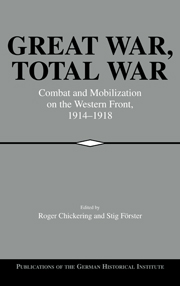Book contents
- Frontmatter
- Introduction
- PART ONE BASIC REFLECTIONS
- 1 From Cabinet War to Total War
- 2 World War I and the Theory of Total War
- PART TWO THE CHANGING REALITIES OF WARFARE
- PART THREE WAR AGAINST NONCOMBATANTS
- PART FOUR POLITICIANS, SOLDIERS, AND THE PROBLEM OF UNLIMITED WARFARE
- PART FIVE MOBILIZING ECONOMIES AND FINANCE FOR WAR
- PART SIX SOCIETIES MOBILIZED FOR WAR
- Index
2 - World War I and the Theory of Total War
Reflections on the British and German Cases, 1914-1915
Published online by Cambridge University Press: 05 January 2013
- Frontmatter
- Introduction
- PART ONE BASIC REFLECTIONS
- 1 From Cabinet War to Total War
- 2 World War I and the Theory of Total War
- PART TWO THE CHANGING REALITIES OF WARFARE
- PART THREE WAR AGAINST NONCOMBATANTS
- PART FOUR POLITICIANS, SOLDIERS, AND THE PROBLEM OF UNLIMITED WARFARE
- PART FIVE MOBILIZING ECONOMIES AND FINANCE FOR WAR
- PART SIX SOCIETIES MOBILIZED FOR WAR
- Index
Summary
“Total war” surely describes World War I. The term itself was born during this vast conflict, which exhibited all the characteristics that have conventionally come to define the concept. The war assembled massive armies from around the globe. The very unwieldiness of these forces in turn encouraged operational paralysis amid continuous battle. The stalemate removed the theater of decision from the battlefield to the home front, where the productive capacities of entire populations were mobilized. Civilians were cast in roles no less essential than soldiers, while commercial warfare, strategic bombing, and the shelling of population centers carried the Avar to the home front and eroded the last practical distinctions between soldiers and civilians. Finally, the intensity and scope of popular mobilization fed the radicalization of war aims everywhere and required that the conflict continue until the destruction or collapse of one side. These features of World War I have lent it paradigmatic status. It was the “first total war,” which was matched in its totality only by the great global conflict that followed a few decades later.
This argument raises a number of methodological problems. These have less to do with the description of World War I than with the place of this conflict in the broader analytical context suggested by the concept of total war. Total war has structured the principal narrative framework of modern military history. The narrative traces the titanic expansion of warfare during the last two centuries, the growth not only of the scope and duration of military operations but also the systematic blurring of lines between soldiers and civilians, between war and society.
- Type
- Chapter
- Information
- Great War, Total WarCombat and Mobilization on the Western Front, 1914–1918, pp. 35 - 54Publisher: Cambridge University PressPrint publication year: 2000
- 8
- Cited by



